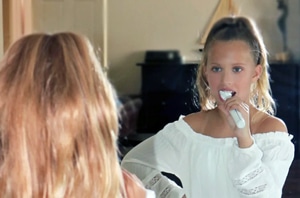
October 28, 2019
Improving Oral Hygiene
By Michael D. Shaw
Dental care, like most types of accessible personal care, has a long history–dating back to Sumer in 5000 BC. Hesy-Re, an Egyptian who died around 2600 BC, boasts the distinction of being the first dentist whose name is remembered. Hippocrates wrote about dental issues, and although other types of dentures were known earlier, the Etruscans are credited with the first practical such products.
Oral hygiene as we know it today was not much practiced in ancient times, but owing to the scarcity of sugar in the diet, tooth decay was quite uncommon. In the Middle Ages, dental health was surprisingly good, again because of the absence of sugar in the diet. The previous link describes methods used at that time to clean the teeth–generally involving cloth and abrasive rubdowns, and they seem reasonably effective.
While tooth decay (dental caries) was not prominent until sugar became popularly priced, people still did lose their teeth for a variety of reasons, the biggest cause being periodontal disease. In this context, we should spend a moment on one of the most famous Americans, who did eventually lose all his teeth–George Washington.
Contrary to the prevailing mythology, Washington did not have wooden teeth. Rather, they were fashioned from ivory, gold, and brass. However, ivory is notoriously difficult to keep clean, so perhaps the mottled brown appearance started the talk of “wooden teeth.”
As to the familiar toothbrush, its history is outlined by the Library of Congress. Crude manual methods were in place to clean teeth as early as 3000 BC, and something resembling a modern-day toothbrush was invented by the Chinese in 1498. This device utilized boar bristles (so much for a “soft” toothbrush) attached to a bamboo or bone handle.
For more than 400 years, boar bristles were used, until the advent of Nylon. Nylon bristle brushes were introduced in 1938, the first one being Doctor West’s Miracle-Tuft. Electric toothbrushes followed in the mid-1950s.
Still, there is the matter of proper brushing technique. An article from a few years ago detailed 14 ways you might be brushing your teeth wrong. These include:
- Not using a soft-bristled brush
- Brushing too hard
- Gripping the brush too tightly
- Brushing at the wrong angle
- Not brushing long enough. Two minutes is recommended.
- Skipping brushing before bed
- Using an old, worn-out brush
Which brings us to Encompass, an innovative toothbrush design from RYCA, Inc. The good folks at RYCA remind us that only one in ten people brush their teeth properly. The unique design of Encompass promises to raise that figure to ten out of ten!
Ryan Schwartz, founder and CEO of RYCA, teamed up with Gerald “Jerry” Brewer, the former director of engineering for Sonicare and Clarisonic, to create the toothbrush of the future. Check out this video to see how it works. Schwartz tells me that RYKA’s mission is to “Improve lives through better oral care. Current toothbrushes on the market don’t effectively address the main cause of poor oral care: compliance.”
This video captures Schwartz’s passion for the new product, as he further explains it.
Schwartz sums things up…
“Our patented J-shaped brush head self-adjusts for a custom fit, and uniformly applies the right angle and pressure to all surfaces of the teeth. Designed by dental professionals and engineered by experts, Encompass is a brush that consumers can trust, as well as a gamechanger for the elderly, caretakers, anyone with motor difficulties, and every parent who’s ever tried to get their kids to brush.”
